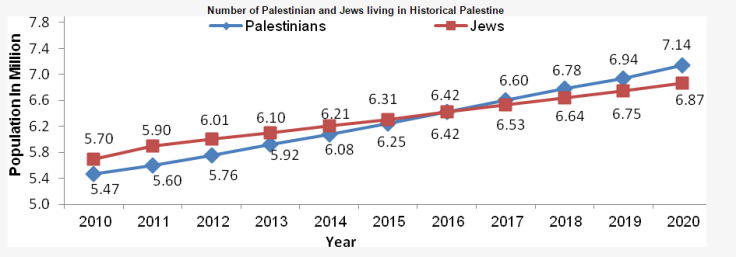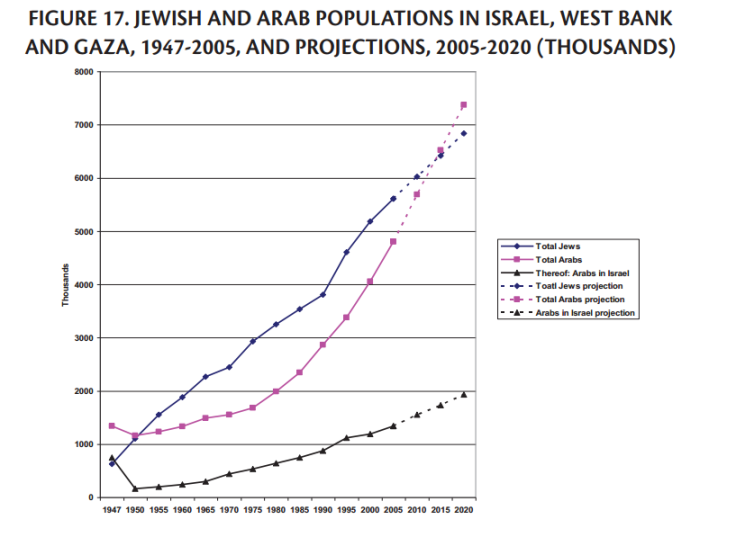Will Palestinians outnumber Israeli Jews by 2016?
Controversy over 'demographic bomb' as Palestinians pursue statehood

The annual population survey from the Palestinian Central Bureau of Statistics (PCBS) has plunged Israeli right-wingers into panic after forecasting Palestinians will outnumber Jewish Israelis in just two years.
The worst nightmare for Zionists and nationalists – that of an Israeli state where an ethnic minority rules over a majority, raising echoes of Apartheid-like system – seems to be approaching at an unrelenting pace.
The PCBS has predicted that the number of Jewish Israelis and Palestinians living in Israel, the occupied West Bank and Gaza "will total about 6.42 million each by the end of 2016 provided that current growth rates remain constant", but that "The number of Palestinians in historical Palestine will total 7.14 million compared to 6.87 Jews by the end of 2020."

The PCBS has made similar predictions in previous years, each time pushing back the tipping point. In 2010 it predicted parity by 2014, in 2011 by 2015, and in 2012 it claimed Arab and Jewish populations would level out at 6.5 million by 2016.
The PCBS has been accused by many Israeli commentators of pumping its figures for political reasons.
Israel does not count its own population in the West Bank and Gaza anymore, and the Bureau is a Palestinian Authority-funded body which uses Palestinian estimates.
In the politically charged Middle Eastern, it is difficult to find reliable and objective data on Palestine's demographic. The CIA World Factbook, which does not cite its sources, puts the number of Palestinians in the West Bank and Gaza at 2.7 million and 1.8 million respectively – just 100,000 lower than the PCBS' estimates.
Questions have been raised over the PCBS' methodology. Former Israeli diplomat Yoram Ettinger, told the Jerusalem Post the Palestinian data "are inflated by more than 1 million in Judea and Samaria [West Bank] and by almost 400,000 in Gaza".
Among the methodological flaws Ettinger claims to have identified is the recording of 400,000 Palestinians from the West Bank who have migrated abroad for more than one year. The diplomat accused the Palestinian bureau not following undefined "international standards" which state "that a person who lives outside his or her country for more than a year should not be included in a count of the resident population".
Another controversial point, according to Ettinger, are Arab residents of eastern Jerusalem who have Israeli identities and so are "counted twice, in the Israeli count of the number of Israeli Arabs and the Palestinian count of the number of residents of the West Bank".
He also claimed that 100,000 children born to overseas Palestinians were included in the PCBS' count.
Ettinger, who is not a professional statistician, has long argued that the PCBS systematically overstates the Palestinian population and that the demographic parity is not something to take for granted.
A factor to consider in assessing Israel's demographics is that in the last decade the Palestinian fertility rate has fallen – as a result of increased access to higher education, a tendency to move to urban areas and growing use of contraception – while the fertility rate amongst Israel's Jewish population is increasing.
Experts have criticised Ettinger, saying that his comments are not based on academic research.
Professor Arnon Soffer from the geography department at the University of Haifa told the Jerusalem Post that "today the percentage of Jews is 52% and in 2024 it will be just 48%".
Another academic, Professor Sergio DellaPergola of Hebrew University, said that "the unquestionably documented fact is that the Arab population in our area is growing and will continue to grow for several years at a pace faster than the Jewish population".
In 2011, DellaPergola argued that the Jewish population would no longer be a majority around 2015.

"If the Jewish population is considered in its core definition, without the over 300,000 non-Jewish members of households, and the over 222,000 foreign workers are added to the total population of Israel, the West Bank and Gaza… the Jewish percentage becomes 49.8%," it said.
"In other words, in 2010 there is no majority of Jews, by the core definition, over the whole territory of the former British Mandate plus the Golan Heights."
The "demographic bomb", as it is called by Israeli Jews, came out as the UN Security Council rejected a Palestinian resolution setting a 2017 deadline for ending Israel's occupation of the West Bank and Gaza, and Palestine began the process of joining the International Criminal Court (ICC), opening the possibility for Israel to be investigated for war crimes.
Israel said the Security Council vote, which followed the collapse in April of US-brokered talks on Palestinian statehood, would deepen the conflict.
© Copyright IBTimes 2025. All rights reserved.





















